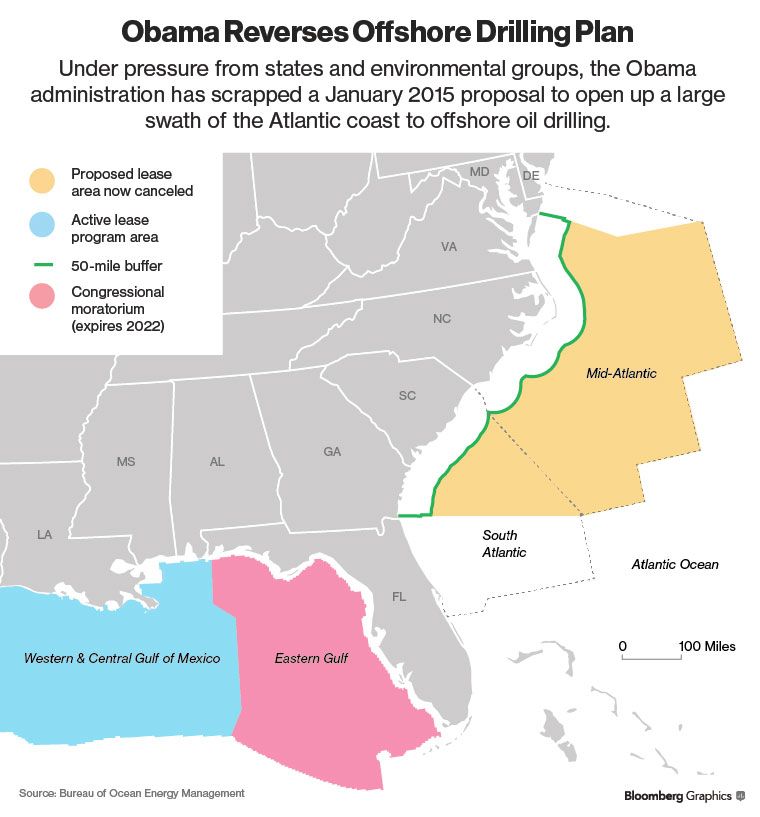Obama Sides with ‘Keep It In the Ground’ Fanatics
KEY TAKEAWAYS:
- Excluding Atlantic coast from offshore drilling is next step in Obama’s “Keep it in the ground” energy strategy.
- President Obama chooses cementing legacy among anti-energy zealots over America’s energy security.
President Barack Obama continues choosing cementing his legacy among anti-energy zealots rather than ensuring America’s energy security.
Instead of the all-of-the-above energy strategy he touted for most of his time in office, the president is going with the “Keep it in the ground” approach preached by radicals like Bill McKibbon.
The Interior Department flip-flopped on leasing portions of the Atlantic coast to oil and natural gas development, Bloomberg reports:
The proposed offshore leasing program being released Tuesday eliminates the administration’s initial plan to auction off drilling rights in as many as 104 million acres of the mid- and south-Atlantic in 2021, according to an Interior Department statement.
In 2015 Interior’s Bureau of Ocean Energy Management (BOEM) proposed leasing parts of the Atlantic coast to energy development. That’s now off the table.

The administration “once again put short term political interests ahead of our nation’s best interest,” Karen Harbert, president and CEO of the U.S. Chamber’s Institute for 21st Century Energy, said in a statement:
America’s job creators have become accustomed to the relentless drumbeat of anti-energy policies from the Obama administration. Today’s announcement that the waters off of our Atlantic coast will be excluded from the next offshore drilling plan is nevertheless remarkable for its catering to fringe constituencies at the expense of energy security and the American economy. The Outer Continental Shelf is the backbone of U.S. oil and gas production and the announced deviation from the proposed plan will cost us jobs and harm security for decades to come.
This isn’t the first time that the administration pulled a Lucy and yanked away the football just before Charlie Brown was about to kick it. The Interior Department pulled out from planned Atlantic coast oil and natural gas leases in 2010.
The New York Times reports, “The decision represents a reversal of President Obama’s previous offshore drilling plans, and comes as he is trying to build an ambitious environmental legacy.”
Interior’s action fits a recent pattern of President Obama abandoning abundant, affordable energy:
- Attacking coal-fired power plants with EPA’s carbon regulations and putting a halt on coal leases on federal lands.
- EPA pushing for methane regulations on oil and natural gas operations when methane emissions have been falling.
- Vetoing the Keystone XL pipeline.
- Putting up regulatory barriers to make it harder for develop energy in the Gulf of Mexico and off California’s coast.
Interior estimates that 3 billion barrels of oil and more than 25 trillion cubic feet of natural gas lie below the mid and southern Atlantic costs.
Because it takes years to lease, explore, plan, and develop offshore projects, cancelling lease sales pushes back any energy development for a generation.
A 2013 study found that opening the Atlantic outer continental shelf to oil and natural gas exploration will create 280,000 jobs. That’s all put on hold.
Leaders in Atlantic coast states support safely developing energy. In 2015 before the House Natural Resources Committee, Governor Pat McCrory (R-N.C.) testified:
Harnessing America’s offshore energy reserves in an expeditious, environmentally safe and responsible manner will lead to greater independence and economic prosperity for North Carolina and the entire nation.
Polls show that those living in Atlantic coast states support energy development because of the jobs and economic growth that would be created. Among registered voters, Harris Poll found 65% support for offshore development in Virginia, 64% in North Carolina, and 67% in South Carolina.
Now, the president’s defenders may note that the Interior Department kept Alaska offshore Arctic drilling under consideration. However, they won’t point out how through excessive regulation, Interior has made it nearly impossible to explore and develop energy there. In addition, Interior could yank those planned leases just like it did off the Atlantic coast.
One thing is for sure, President Obama has decided that improving access to American energy isn’t in the cards for the rest of this presidency. The decision made today will have ramifications for 10-15 years to come, not just until Jan 20, 2017.
MORE ARTICLES ON: ENERGY
EDITORS NOTE:The featured image is of tug boats move a oil platform to the Gulf of Mexico. Photo credit: Eddie Seal/Bloomberg.



Leave a Reply
Want to join the discussion?Feel free to contribute!